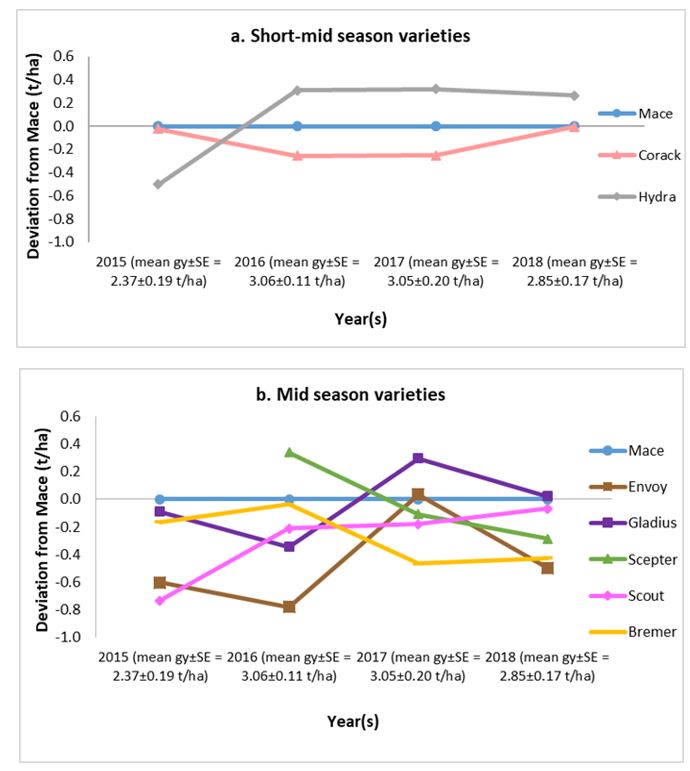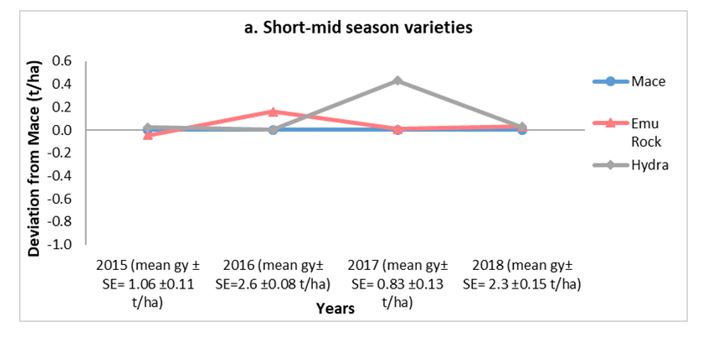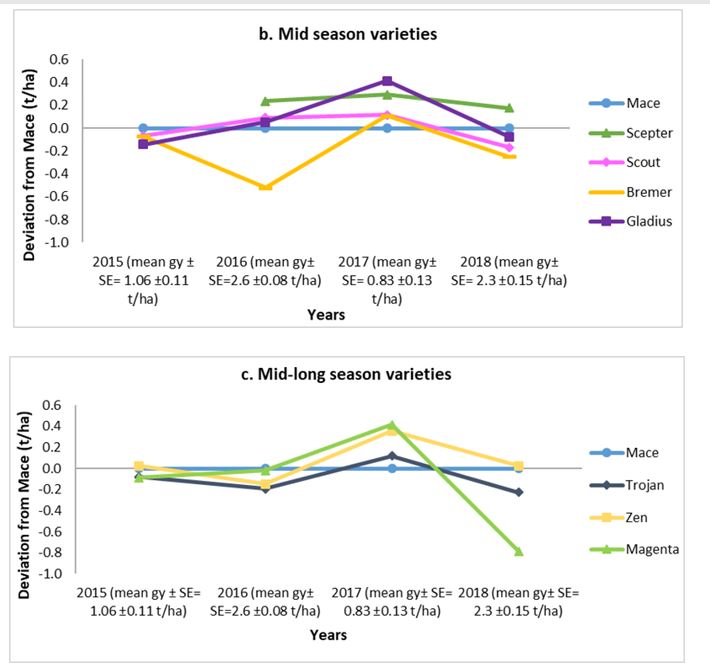Best performing wheat varieties on sodic and dispersive soils at Merredin and Broomehill
Author: Sharmin Rahman, Rosemary Smith, Mario D’Antuono and Darshan Sharma, DPIRD | Date: 25 Feb 2019
Key Messages
- At both sodic sites - Broomehill (medium rainfall) and Merredin (low rainfall), short-mid season wheat varieties Hydra and Scepter generally yielded higher or equal to Mace.
- Of the mid-long season varieties, Zen has been the best performer on both sites.
Aims
To identify wheat varieties suitable for alkaline sodic and dispersive soils in the medium and low rainfall zones of Western Australia.
Background
Sodic soils in Western Australia are characterised by dispersion and degraded structural properties. Sodic soils can reduce grain yield due to associated limitations posed by high salt concentrations, nutrient deficiencies and boron, carbonate and aluminate toxicities (Rengasamy, 2002). Farming practices under dryland conditions further exacerbate this problem. Wheat varieties tolerant to soil sodicity could make the farming enterprise more profitable and economically viable. The current project explored tolerance levels of a number of Australian wheat varieties to sodicity and yield response under different rainfall regimes. This paper highlights yield performance of selected wheat varieties over four years on sodic soils in medium and low rainfall environments of Western Australia.
Method
Field trials were conducted in four successive years starting in 2015 at an alkaline sodic site in Merredin (low rainfall area) and at an alkaline sodic dispersive site in Broomehill (medium rainfall area). Soil chemical analysis, dispersion tests and a near surface electromagnetic (EM38) survey were used to validate site requirements. A summary of soil characteristics of the two sites is presented in Table 1.
In 2018, up to 22 wheat varieties with three replications were seeded in a latinised-randomised block designs with 12 columns by 12 rows (6 rows, each with paired yield plots) whereas in previous year, up to 46 varieties were tested. However, at Broomehill, in 2018 only two replications were used for the selected varieties. Every year, Mace was used as the repeated check with even distribution across replication blocks. Wheat varieties suited to WA conditions as well as some from other States were included in these current trials but this paper shows only the WA relevant varieties.
Table 1. Soil characteristics at the two sodic sites selected for trials
Trial conditions | Medium Rainfall
| Low Rainfall |
|---|---|---|
Location | Broomehill (Nathan Heron’s property) | Merredin Research Station |
Soil Texture | Hard-setting grey clay | Hard-setting loamy clay |
ESP (%) | 3 to 18 Increasing to depth | 5 to 15 increasing with depth |
Dispersion | Low to high, increasing with depth | High to medium, variable throughout |
ECe (dS/m) (upto 75cm) | 0.6 to 1.8 increasing with depth | 0.8 to 1.8 increasing with depth |
pH (H20) | 6.1 to 10.7 Increasing with depth | 5.5 to 9.5 Increasing with depth |
Cumulative growing season rainfall (April to November) for all four years is illustrated in Figure 1. Of those four years, 2016 received the highest amount of precipitation. In 2018, rainfall at Merredin was the lowest (figure 1b) and that at Broomehill was similar to 2015 (figure 1a).
Figure 1. Cumulative rainfall over four growing season (April to November) at (a) Broomehill and (b) Merredin
Results
Sowing dates with average grain yields for four seasons are provided in Table 2. Grain yield was the highest in 2016 at both locations and lowest in 2015 at Broomehill and in 2017 at Merredin. Despite lower rainfall in 2018, grain yield at both sites was higher in comparison to seasons with similar rainfall during previous years.
Table 2. Sowing Dates and Average Grain Yields at Broomehill and Merredin
Locations and Growing seasons | Broomehill | Merredin | ||
|---|---|---|---|---|
Sowing date | Mean yield (t/ha) ± SE | Sowing date | Mean yield (t/ha) ± SE | |
2015 | 12 JunM | 2.37±0.19 | 16 JanVD | 1.06±0.11 |
2016 | 2 JunM | 3.06±0.11 | 3 JunM | 2.60±0.08 |
2017 | 2 JunD | 3.05±0.20 | 31 MayD | 0.83±0.13 |
2018 | 18 JunD | 2.85±0.17 | 15 JunM | 2.30±0.15 |
‘M’, ‘D’ and ‘VD’ indicate moist, dry and very dry conditions
Grain yield of twelve promising varieties over four years in the two different environments is presented in Figure 2 and Figure 3.
Varietal performances are presented as Production Values (deviation from Mace). Varietal comparisons are shown within maturity groups namely, short-mid, mid and mid-long.
Medium Rainfall Sodic Site – Broomehill
Except in year 2015, there were varieties that out-yielded Mace at this site.
Figure 2. Production values of 11 wheat varieties at the Broomehill sodic site compared to Mace from 2015 to 2018. Y-axis shows grain yield (t/ah) difference from Mace in respective years.
Hydra, a short-mid season variety, yielded greater than Mace since 2016 (figure 2a). In the mid-season group, Scepter and Gladius yielded similar or better than Mace (figure 2b). In the mid-long season group, variety Zen demonstrated the most stable performance and yielded generally similar to Mace (figure 2c). Envoy, Bremer, Trojan, Magenta, Scout and Calingiri showed inconsistent performance and were more often poor performers than Mace at this site.
Low Rainfall Sodic Site – Merredin
Production values of nine varieties from 2015 to 2018 at Merredin are presented in Figure 3. Of the four years, 2018 was the driest at Merredin and plants were particularly stressed between tillering and anthesis.
At this sodic site, most of the short-mid and mid-season varieties performed equal to or better than Mace. Scepter was tested only for three years and performed better than Mace in all three years. Varieties Gladius, Scout, Zen and Trojan were very consistent and produced similar to that of Mace. Magenta had better or equal performance to Mace for the first three years. An interesting observation was found for Bremer which yielded inconsistently at both locations indicating further detailed study is needed to reveal the underlying reason.
Figure 3. Production values of nine wheat varieties at the Merredin sodic site compared to Mace from 2015 to 2017. Y-axis shows grain yield (t/ha) difference from Mace in respective years.
Conclusion
Analysis and comparison of the four years yield data demonstrated that wheat varieties differed for consistency of performance at sodic soils at both low and medium rainfall locations. Varieties such as Hydra and Scepter did well at both sites. Among mid-long season varieties, yield performance of noodle wheat Zen was more stable and generally equal to or better than Mace at both sites.
Acknowledgments
The research project is a co-investment by GRDC. Nathan Heron provided land and assistance in trial implementation at Broomehill. DPIRD TSU staff from Merredin and Katanning provided seeding, harvesting and agronomic management of the trials throughout the season.
GRDC Project Number: UA00159
Paper reviewed by: Dr. Raj Malik
References
Rengasamy, P. (2002). Transient salinity and subsoil constraints to dryland farming in Australian sodic soils: an overview. Australian Journal of Experimental Agriculture, 42(3), 351-361.
GRDC Project Code: UA00159,
Was this page helpful?
YOUR FEEDBACK





